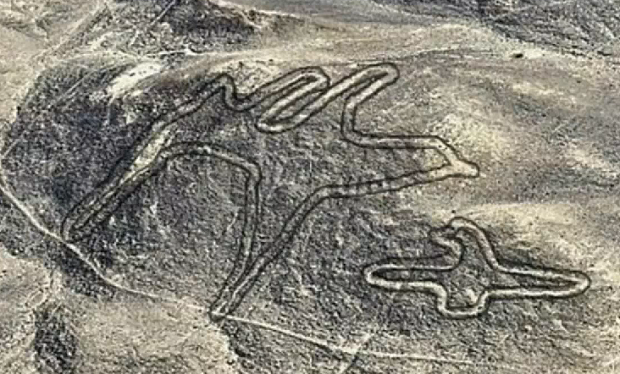2000-year-old undiscovered Nazca Lines resurfaced after a Sandstorm in Peru

The Nazca lines are a peculiar series of ancient patterns and designs that can be found in the Peruvian desert which are only visible from the air.
These ancient figures are made by the ancient tribes of Nazca, who lived in the area from 500 B.C. and 500 A.D., and some consider these designs as the “crop circles” of South America. Just like crop circles, the process to create geoglyphs, and their purpose remains a mystery until today, but the mystery continues with the new discoveries.
Three more huge geoglyphs surfaced on in late July, and they are estimated to be 2000 years old. The new figures were spotted by Eduardo Herrán Gómez de la Torre, a pilot and Nazca lines researcher while he was flying his airplane over the Peruvian desert. The newly found geoglyphs were a figure of a bird, a camel or llama and 200-feet long snake. A recent gale and sandstorm are thought to have revealed the previously unseen ancient designs.
Eduardo Herrán Gómez said that the designs might be one of the creations that the prehistoric culture of Paracas made. The Paracas are well-known for their elegant art and fabric. The culture ruled southern Peru from 800 B.C to 100 B.C and predated the Nazca culture who lately ruled the region during 100 B.C to 800 A.D.. The recent discovery will somehow bring new understanding on the ancient Nazca people.
The Nazca lines stretch about 280 square miles in the coastal plain areas of the Peruvian desert. The UNESCO recognizes it as a World Heritage for its geometrical designs and depiction of animals and plants. Some say that these designs had ritual astronomic functions as they can only be seen up in the air. Famous Nazca lines figures were the hummingbird, orca, spider, shark and the famous waving alien or astronaut friend.
Whatever the Nazca lines purpose are for the ancient inhabitants of Peru, its unrivaled uniqueness and diversity adds up to the magnificent artistic achievements of the prehistoric world. The Nazca lines will continue to capture the imagination of our present world and it will continue to do so in our future.



 Creators of mankind
Creators of mankind Description of “Tall white aliens”
Description of “Tall white aliens” Where they came from?
Where they came from? About hostile civilizations
About hostile civilizations The war for the Earth
The war for the Earth “Tall white aliens” about eternal life
“Tall white aliens” about eternal life Video: “Nordic aliens”
Video: “Nordic aliens” Aliens
Aliens Alien encounters
Alien encounters The aliens base
The aliens base UFO
UFO Technology UFO
Technology UFO Underground civilization
Underground civilization Ancient alien artifacts
Ancient alien artifacts Military and UFO
Military and UFO Mysteries and hypotheses
Mysteries and hypotheses Scientific facts
Scientific facts


















